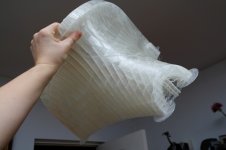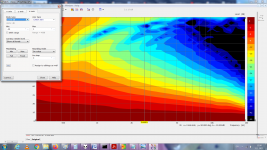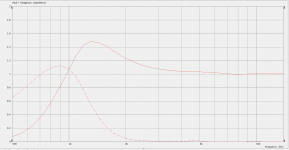I think it is right, it matches the waveguide woofer simulation I did. The two interact with each other much less with a 180 termination on the guide.Well maybe this explanation is completely wrong, that's also perfectly possible - it's only my best effort to understand what's going on.
When I drive the woofer in the sim instead that should be more confirmation.
TNT what mabat is showing is how well the termination works in guiding waves from both directions.
With the 180 termination when sound comes from behind less of it makes it's way to the front because of the termination, just the same as when viewing the termination from the front less sound wraps around the back.
But I cant understand how a wave can come from behind in free field.
fluid, in your simulation I can understand it as ther is in fact something behind - a reflector as well as an exciter to interfere with,
//
Last edited:
But basically yes, it would be what you show. Waves just go around obstacles, diffract and reflect all the time.
Last edited:
I think that is where your confusion is coming from. You are right that in a free field there won't be a wave from behind unless there is there is a source behind the guide.But I cant understand how a wave can come from behind in free field.
fluid, in your simulation I can understand it as ther is in fact something behind - a reflector as well as an exciter to interfere with,
//
But in reality sound will come from all directions once it has been released into a room due to reflection and diffraction from various surfaces.
Sometimes in a simulation something that would not exist in reality has to be used to demonstrate the principle.
Actually, there is a source behind the guide even if there's no wall. Many small sources, in fact, at all the points where diffractions occur. For example at the very back of the waveguide body. And that's just one of many.You are right that in a free field there won't be a wave from behind unless there is there is a source behind the guide.
The directivity of all this will be stupendously complex but it's almost certain that some of the waves on some frequencies will be directed at the mouth edge again.
Last edited:
mabat do you have the predictions for the sand printed horns in the new Ath report format or vacs to see what directivity you finally chose for them?
Hopefully I will have measurements soon 🙂
- As for the previous debate, maybe the best way to look at what diffracts back from the rear side of the waveguide would be via time windowing of the impulse response at the late enough time interval, excluding the direct sound and the first edge reflection. Or some spectral-time analysis - I've never done this much so this may be a good opportunity to try.
- As for the previous debate, maybe the best way to look at what diffracts back from the rear side of the waveguide would be via time windowing of the impulse response at the late enough time interval, excluding the direct sound and the first edge reflection. Or some spectral-time analysis - I've never done this much so this may be a good opportunity to try.
Last edited:
Iwata 300 print TPU65D - low resonance low decay, low weight, 16mm wall.
That looks like a solid chunk of waveguide!
Hopefully I will have measurements soon 🙂
- As for the previous debate, maybe the best way to look at what diffracts back from the rear side of the waveguide would be via time windowing of the impulse response at the late enough time interval, excluding the direct sound and the first edge reflection. Or some spectral-time analysis - I've never done this much so this may be a good opportunity to try.
Somebody said source behind wave guide?
International
hi
i am very curious about your findings as i have just ordered the same CD's and was wondering what horns to use . is there more information on the horns you will be using ?
thanks
malcolm
i am very curious about your findings as i have just ordered the same CD's and was wondering what horns to use . is there more information on the horns you will be using ?
thanks
malcolm
The drivers are waiting for their waveguides 🙂
- The smaller waveguides should arrive next week, the larger come next.
Auto-Tech JMLC-400 Horn
- Home
- Loudspeakers
- Multi-Way
- Acoustic Horn Design – The Easy Way (Ath4)


